'It all started with a gif of a cat': How Gwent went from minigame to gorgeous standalone CCG
Gwent has its own identity now, and some of the best art in card games.
Art director Katarzyna Redesiuk had been asked to come up with a unique concept for premium Gwent cards. While the version of Gwent in The Witcher 3 hadn't needed premium cards, once the idea to transform that minigame into a full collectible card game spin-off was in place, something that denoted value and rarity was called for. Something luxe to evoke the foils of Magic: The Gathering, or the holo cards from the Pokémon game Redesiuk had played as a kid.
Though called "holos" in Pokémon, there was nothing holographic about those rare Charizards and Machamps. They just had shiny backgrounds that gleamed a bit when tilted. What if they were closer to actual holograms? Redesiuk found an example of the effect she was looking for on the internet and presented it to the rest of the team.
"It all started with a gif of a cat that was animated in a way that it showed some parallax effect," says Gwent's current art director, Remigiusz Nowakowski (Redesiuk moved on to fill the same role on another CD Projekt Red game: Cyberpunk 2077). "It sparked the idea of making those cards look different than, you know, just slapping a foil on the illustration."
The parallax effect was a good idea but it needed more, and soon Gwent's prototype premium cards were animated as well—each one an entire looping scene telling a tiny story. Geralt uses the Aard sign to hurl two enemies off a cliff, Ciri teleports through a pack of wolves with her sword flashing.
To support this, Gwent's non-premium cards couldn't feature the usual static images. If they were going to become exciting animations, then even non-animated they would have to be dynamic. The Siege Support card, which in The Witcher 3 was called Kaedweni Siege Expert and featured an un-thrilling illustration of a man holding a stick, now shows a soldier struggling to adjust the crank on a siege engine while lashed by a howling storm. Others stab swords, bang drums, and race dragons.
It's a videogame after all—we want to see characters doing things, not posing. "We write entire little story briefs for the illustrators before they even start," says Gwent's game director Jason Slama, "and we always try to make sure there's some sort of action or scene, not just a character."
There's a surprising amount of writing in Gwent. There's a rewards book where you spend keys earned from achievements on currency and cosmetics that also includes entire encyclopedia entries. Regular events called Journeys are accompanied by short stories that unfold week by week, and every leader has their own taunts. "The amount of time we spend writing battle cries," Slama says with a sigh. Then there's the lines of description on cards themselves, like the quote that describes the Ballista: What crossbows want to be when they grow up. Slama calls them the "fluffs", these snippets of flavor text. "If you don't read the fluffs, read the fluffs there! We have a lot of work put into them as well."
The biggest gaming news, reviews and hardware deals
Keep up to date with the most important stories and the best deals, as picked by the PC Gamer team.
We tried to stick so close to the original Gwent in the beginning.
Maciej Ostrowski
I didn't play much Gwent in The Witcher 3. I was busy tracking down Ciri, stopping the Wild Hunt, deciding who should rule Skellige—I didn't have time for a minigame. Obviously a lot of other people did, and that singleplayer incarnation of Gwent is fondly remembered by many players. Making it into a spinoff was an easy decision.
"That was really not a hard sell to be honest," says Slama. "We had a lot of fans asking for it. We even had a group of people modding The Witcher 3 so every battle was a Gwent battle. Yeah, that sends you a pretty strong signal."
Slama had worked on the original version, helping to transform "a bunch of design documents, some of them contradicting each other", into something digital. To understand the concept, he played a paper prototype against one of Gwent's creators, Rafał Jaki, which made the core of the design obvious. It was about bluffing—trying to convince the other player that you're playing your best cards sooner than you actually are, pushing them to overcommit and leave you with more points in the next round. As common a tactic as bluffing is in physical card games, it's rare in digital ones. "That's a different dynamic than just, you know, slap the face of the opponent until he has less numbers next to his face," Slama says.
While the AI in The Witcher 3 was programmed to act as if it was either bluffing or falling for bluffs, it's an idea well-suited to a multiplayer game played against real humans. But when the time came to take Gwent out of Geralt's hands, everything else about it proved trickier to translate. "The problem was we tried to make a CCG out of the minigame," says lead gameplay designer Maciej Ostrowski. "We tried to stick so close to the original Gwent in the beginning. What was fine in a minigame in Witcher 3 doesn't really work in CCG. And that was one of the big problems."
Homecoming
The version Geralt played against shopkeepers, drawing a hand of 10 cards from his deck and laying them out over three rows, was kind of inert. Though some of those cards had abilities, like Scorch, Medic, Tight Bond, or the wildly overpowered Spy cards everyone built their decks around, many were just a number. And losing against someone because their cards had higher numbers than yours isn't a lot of fun.
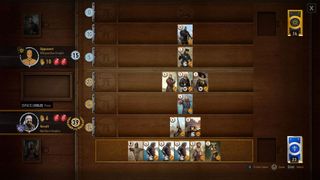
That was far from the only issue. "The old Gwent had a lot of problems, and we wanted to fix them," says Ostrowski, who goes so far as to "maybe even call it a game with a rotten foundation." Thing is, the game was already in players' hands by the time many problems became obvious. It had been in open beta for almost a year when CD Projekt Red announced they were going to spend six months intensely retooling it before release, dubbing this process, and the resulting final version, "Homecoming".
We don't have attacking face, we don't have life, it's all about playing cards
Maciej Ostrowski
One of the things that needed fixing were tutoring cards, which let you play extra cards and could be made into combos. "Gwent is one card per turn," says Ostrowski, "while with those cards, you could get two cards per turn. If you put more of them, you could get even more because one played another card that plays another card, and it created long chains. The best decks in Gwent at that time were just filled with tutoring cards, like 80 percent of your decks were just tutor cards."
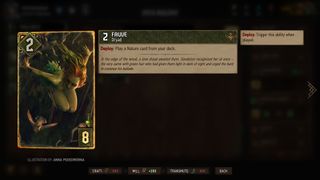
If a tactic is effective, how do you stop players from overusing it? "I think this is a side effect of the fact that we don't have a mana system," says Slama. "In other games, if it's a stronger creature you make it cost more to play. Well, we don't have that. So we needed to find an alternative way to balance the game."
The solution was the provision system, which gave each card a cost separate from the number representing its effect on your score. This went hand in hand with the removal of leader cards. The various faction heads had been cards that needed to be drawn from your deck to use their abilities. Now they became 3D figures who stood on the side of the board, their abilities free to activate at any time. The leader ability you choose sets a cap on the amount of provisions you're allowed—less powerful leader abilities let you construct a more powerful deck. Sure, you can put in some of those cards that let you spawn other cards. But it'll cost you.
Another change was the introduction of orders, abilities that can be triggered from already-played cards by spending charges. Some cards have a single charge that can be spent the turn after they're played, others have multiple charges or regenerate them under certain conditions. It means the board state can shift, and there's more to do on any given turn than just play or pass.
"We don't have attacking face, we don't have life, it's all about playing cards," says Ostrowski. "But before it was: You're playing a card and that was it. That was all of your interaction. Maybe it had passive ability, but not the ability to interact with it in any way."
With the addition of orders and charges that was no longer true. If someone plays Vysogota of Corvo (the old man in the swamp who looks after Ciri in the books), they can use his order to boost a unit by one point—which doesn't seem like much, except that he gains a charge whenever a card is played by either player. Late in a round, that's not great value. Early in a round, he's an engine for churning out buffs and a valuable target. "I think this added another layer to the game," says Ostrowski, "of tactics and interactions between the players and the cards."
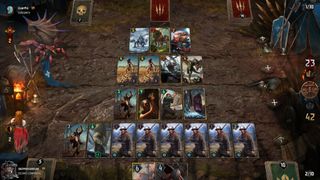
All in all, Ostrowski estimates 80 or 90 percent of Gwent's cards were reworked by Homecoming. Artifact cards were added, the silver tier removed, and weather effects reduced. Meanwhile, the board lost its middle lane, and redraws—called mulligans in CCG jargon—were added between each round, rather than just at the start of the game, to reduce the influence of chance. "In original Gwent you didn't have this," Ostrowski explains. "It was 10 cards, you play with it. But as we were testing the game, I think it was the Nilfgaardian ability at some point, the faction ability. They had mulligans, and people were playing Nilfgaard a lot."
Now everyone could mulligan, and Nilfgaard fans have never quite got over it. In fact, a lot of players were frustrated by the sweeping changes implemented in Homecoming, and how different standalone Gwent was becoming from the version they'd played so much of in The Witcher 3.
"This was kind of terrifying," says Slama. "I think it's easy to underestimate how many big risks we took with this update, but I think they were really important things to build a stronger foundation. And while it was scary, and while I don't think we got off on the strongest foot and I can totally understand why people would be frustrated with what we launched at Homecoming, I think that we've worked really hard to show and achieve our original intent since then."
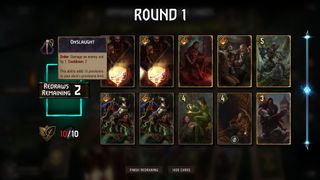
It's true that Gwent became a different game with Homecoming, and players had to relearn a lot of rules. But the change was a valuable one, which in the long run has given Gwent an identity of its own, something it sorely needed. As it stood in The Witcher 3, Gwent was a little too close to its main inspiration: Condottiere, a card game designed by Dominique Ehrhard.
Though Condottiere doesn't have deckbuilding and its theme is mercenary conflict between Italian city-states, it plays the same and some of its cards have direct equivalents in Gwent. Condottiere's scarecrow, a one-point card that could be swapped to return a higher-value card already in play, was mirrored by Gwent's decoy, which even had a similar illustration. Taking Gwent further from its Witcher 3 incarnation gave it more of its own identity, and today it no longer feels like a reskin of Ehrhard's design.
Wandering in the dark
Though there were plenty of complaints at the time, Homecoming was eventually accepted by the community. Gwent became one of those card games, like Magic: The Gathering Arena, Legends of Runeterra, and Shadowverse, that Hearthstone players recommend to each other every time Blizzard does something to alienate them again.
You have any idea how hard it is to dissect the Witcher timeline and actually add to it without becoming incoherent?
Jason Slama
Not everything has gone well for Gwent, though. In June 2020, support for the PlayStation 4 and Xbox One versions had to be dropped because, "We were spending a lot of time supporting those versions, more than any other platforms," as Slama explains. "The way it was set up was forcing our timetables to be locking entire products and concepts in really far ahead of time. We don't have the giant development team, thousands of people working on Gwent. Like, we're not that big, and every resource that we put in is super valuable."
Though they were pleased with the console ports, adding fun little features like the PS4 controller's light changing color to match the faction you were playing, the time saved by dropping support for them seems to have made it easier to add more to Gwent in terms of gameplay options. The draft mode, for instance, though it's in early access and still has a way to go. "I think there needs to be longer-term goals and some sort of ladder or ranking system as well as some ways for your deck to evolve as you play matches," Slama says.
And then there's the Way of the Witcher expansion, which comes with 70 new cards. Ostrowski is particularly excited by this. "[When] we have to actually start working on new cards, it's like, 'Yeah!'" he says enthusiastically, as the others laugh. "But you know, this is the best time of the year. I think it's fun, implementing is fun, but the best time is when we are starting to talk about new expansions."
Though its full name is Gwent: The Witcher Card Game, actual witchers are only rarely played in the popular decks. Geralt's philosophy of neutrality makes him a perfect fit as a neutral card, usable by any faction but essential to none. Among the additions of the Way of the Witcher are cards representing historical monster hunters who founded the various witcher schools, each designed to suit an existing faction but alter their playstyle. Another recent addition from Witcher lore is Alzur the mage, a character mentioned in passing in the books and short stories who is credited with creating the first witchers, and who has been fleshed out by the Gwent team.
"I think it's super interesting and exciting that we've actually put a face on the guy who created witchers. That didn't exist before," says Slama. "You have any idea how hard it is to dissect the Witcher timeline and actually add to it without becoming incoherent? It's a lot of work. But I think it also lets us make some pretty exciting things."
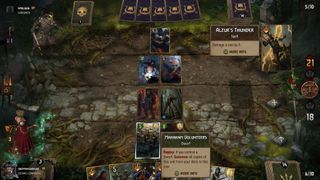
Every new addition carries with it a risk. While a new set of cards should ideally shake up the meta (I expect my triple duel shieldwall Northern Realms deck to be taken down a peg or two), there's a danger of going too far, of making it seem like people who pay for the latest toys have an unfair advantage and everyone else has been left behind.
I think it's fair to say that we all love Toss a Coin to Your Witcher
Remigiusz Nowakowski
"What we want to do is create more gameplay options for you," says Slama, "more interactive stuff than just, 'Hey, here's the shiniest new thing, that thing that used to play sucked.' Do we always succeed at that 100 percent? No, balancing a card game is hard—news alert! This, as noble a goal as it is, is not just snapping some fingers. I think it's always easy to go into the armchair and go, 'You change this by one and there you go. My thing is super powerful again.' Yeah, it's not always so simple."
The ballad of Gwent
Back in 2019, The Witcher received a boost in public consciousness when the Netflix adaptation of the books debuted. The staff at CD Projekt Red watched it, of course. "I think it's fair to say that we all love Toss a Coin to Your Witcher," says Nowakowski. "I heard it being sung in the corridors so many times."
"I think they did some interesting bold choices," says Slama. "I enjoyed it overall. And I think it's really cool to see the Witcher brand get so much attention and love, right? I think more than anything, it adds excitement to us working on that. Hey, look, you know that thing you just watched on Netflix that's all over the walls? You're working on the card game of it."
Their own vision of the Witcher world remains paramount. While the TV show adapts the books rather than the games, many of the characters from those books have already made their way into Gwent, and been memorably illustrated. The mage Vilgefortz, for instance, has one of the more horrifying depictions, especially on the animated premium version. He cackles as he burns a man alive, his victim's head going up like a candle.
It's a long way from Pokémon holos and the cat gif that inspired the animations. It's my favorite card, and frankly it's pretty disturbing. "We think the Witcher world is a dark, dark fantasy world," says Nowakowski, summing up the tone Gwent aims for. "It's not a high fantasy where one wizard could, with a snap of his fingers, change their whole surroundings. There are rules. It's more grounded, it's more gritty and kind of gory in a way. We believe that the world is a beautiful place occupied by monsters."

Jody's first computer was a Commodore 64, so he remembers having to use a code wheel to play Pool of Radiance. A former music journalist who interviewed everyone from Giorgio Moroder to Trent Reznor, Jody also co-hosted Australia's first radio show about videogames, Zed Games. He's written for Rock Paper Shotgun, The Big Issue, GamesRadar, Zam, Glixel, Five Out of Ten Magazine, and Playboy.com, whose cheques with the bunny logo made for fun conversations at the bank. Jody's first article for PC Gamer was about the audio of Alien Isolation, published in 2015, and since then he's written about why Silent Hill belongs on PC, why Recettear: An Item Shop's Tale is the best fantasy shopkeeper tycoon game, and how weird Lost Ark can get. Jody edited PC Gamer Indie from 2017 to 2018, and he eventually lived up to his promise to play every Warhammer videogame.
Most Popular

